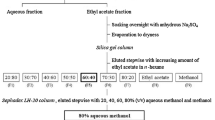Abstract
The ethyl acetate extracts ofRorippa indica Hiern. contained hirsutin, arabin, camelinin, and three novel ω-methylsulfonylalkyl isothiocyanates (n=8, 9, and 10). These compounds severely inhibited lettuce (Lactucasaliva) hypocotyl and root growth at 0.1 mM or above. The precursor glucosinolates of hirsutin, arabin, and camelinin were isolated. Presence of the three ω-methylsulfonylalkylglucosinolates, along with other glucosinolates in the roots were verified by the isolation and identification of their desulfoderivatives. Using the continuous root exudate trapping apparatus and GC-MS, hirsutin and the threeω-methlylsulfonylalkyl isothiocyanates were detected in the root exudates ofR. indica, suggesting that these isothiocyanates are the primary candidate of allelopathic compounds contributing to the aggressiveness of this cruciferous weed.
Similar content being viewed by others
References
Chisholm, M.D. 1972. Biosyntheis of 3-methylthiopropylglucosinolate and 3-methylsulfinylpropylglucosinolate in wallflowerCheiranthus kewensis.Phytochemistry 11:197–202.
Einhellig, F.A. 1986. Mechanisms and modes of action of allelochemicals, pp. 171–188,in A. R. Putnam and C.-S. Tang, (eds.) The Science of Allelopathy. John Wiley & Sons, New York.
Einhellig, F.A. 1987. Interactions among allelochemicals and other stress factors of the plant environment, pp. 343–357,in G.R. Waller, (ed.) Allelochemicais: Role in Agriculture and Forestry. American Chemical Society, Washington, D.C.
Fenwick, G.R., Heaney, R.K., andMullin, W.J. 1983. Glucosinolates and their breakdown products in food and food plants.CRC Crit. Rev. Food Sci. Nutr. 18:123–201.
Harborne, J.B. 1988. Introduction to Ecological Biochemistry, 3rd ed. Academic Press, London. pp. 312–315.
Ishii, G., Saijo, R., andMizutani, J. 1988. Analysis of glucosinolates in cabbage and radish roots by HPLC and FD-MS.Nippon Nogeikagaku Kaishi 62:1221–1223.
Ito, M., Urago, A., andKawakami, M. 1989. Vegetative reproduction of weeds by the root segments.Weed Res. Jpn. 34:141–142.
Kawabata, J., Fukushi, Y., Hayashi, R., Suzuki, K., Mishima, Y., Yamane, A., andMizutani, J. 1989. 8-Methylsulfinyloctyl isothiocyanate as an allelochemical candidate fromRorippa sylvestris Basser.Agric. Biol. Chem. 53:3361–3362.
Kjaer, A., andChristensen, B. 1957. Isothiocyanates XXVI. Straight-chain ω-methylthioalkyl isothiocyanates and some derivatives.Acta Chem. Scand. 11:1298–1307.
Kjaer, A., andChristensen, B. 1958. Isothiocyanates XXX. Glucohirustin, a new naturally occurring glucoside furnishing (−)-8-methylsulfinyloctyl isothiocyanate on enzymatic hydrolysis.Acta Chem. Scand. 12:833–838.
Kjaer, A., andGmelin, R. 1956. Isothiocyanates XXIII.l-(−)-9-Methylsulphinylnonyl isothiocyanate, a new mustard oil present as a glucoside (glucoarabin) inArabis species.Acta Chem. Scand. 10:1358–1359.
Kjaer, A., Gmelin, R., andJensen, R.B. 1956. Isothiocyanates XXI. (−)-10-Methylsulphinyldecyl isothiocyanate, a new mustard oil present as a glucoside (glucocamelinin) inCamelina species.Acta Chem. Scand. 10:1614–1619.
McGregor, D.I., Mullin, W.J., andFenwick, G.R. 1983. Review of analysis of glucosinolates.J. Assoc. Off. Anal. Chem. 66:825–849.
Mizutani, J., andYamane, A. 1991. Chemodynamics of glucosinolates in Kireha-inugarashi,Rorippa sylvestris.Weed Res., Jpn. 36:68–73.
Olsen, O., andSørensen, H. 1981. Recent advances in the analysis of glucosinolates.J. Am. Oil Chem. Soc. 58:857–865.
Tadano, T., andTanaka, A. 1976. Differences for crop species of ammonium and nitrogen suitability.Nippon Dojo-Hiryogaku Zassi 47:321–328.
Tang, C.-S. 1971. Benzyl isothiocyanate of papaya fruit.Phytochemistry 10:117–121.
Tang, C.-S., andTakenaka, T. 1983. Quantitation of a bioactive metabolite in undisturbed rhizosphere-benzyl isothiocyanate fromCarica papaya L.J. Chem. Ecol. 9:1247–1253.
Tang, C.-S. andYoung, C.C. 1982. Collection and identification of allelopathic compounds from the undisturbed root system of bigalta limpograss (Hemarthia altissima).Plant Physiol 69:155–160.
Truscott, R.J.W., Minchinton, I.R., Burke, D.G., andSang, Y.P. 1982. A novel methoxyindole glucosinolate.Biochem. Biophys. Res. Commun. 107:1368–1375.
Virtanen, A.I. 1965. Studies on organic sulphur compounds and other labile substances in plantsA review.Phytochemistry 4:207–228.
Author information
Authors and Affiliations
Rights and permissions
About this article
Cite this article
Yamane, A., Fujikura, J., Ogawa, H. et al. Isothiocyanates as alleopathic compounds fromRorippa indica Hiern. (Cruciferae) roots. J Chem Ecol 18, 1941–1954 (1992). https://doi.org/10.1007/BF00981918
Received:
Accepted:
Issue Date:
DOI: https://doi.org/10.1007/BF00981918




